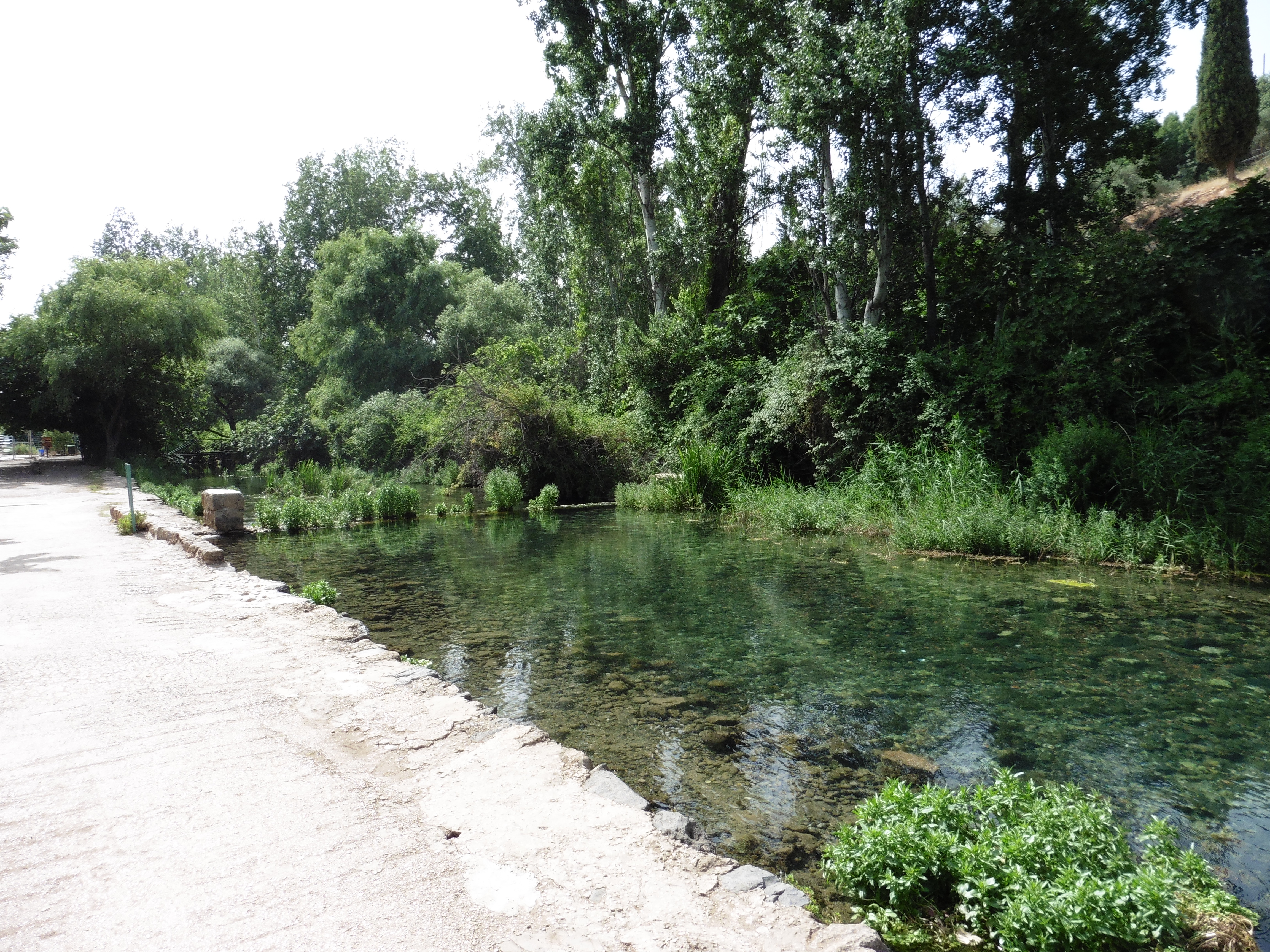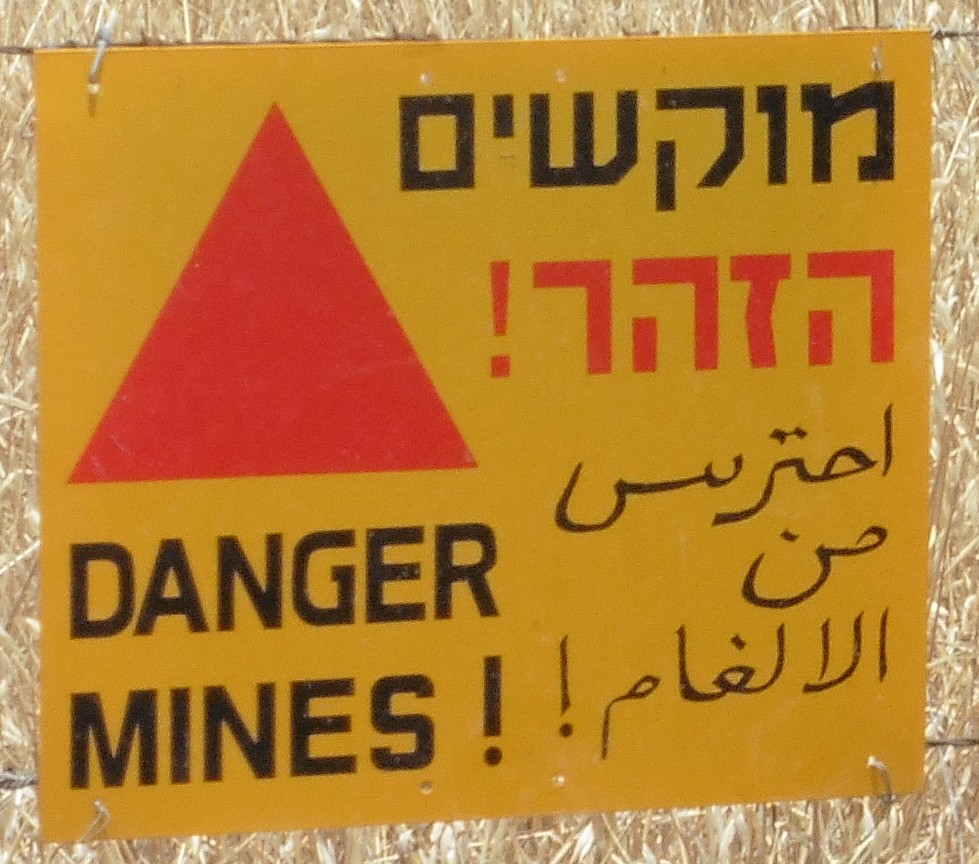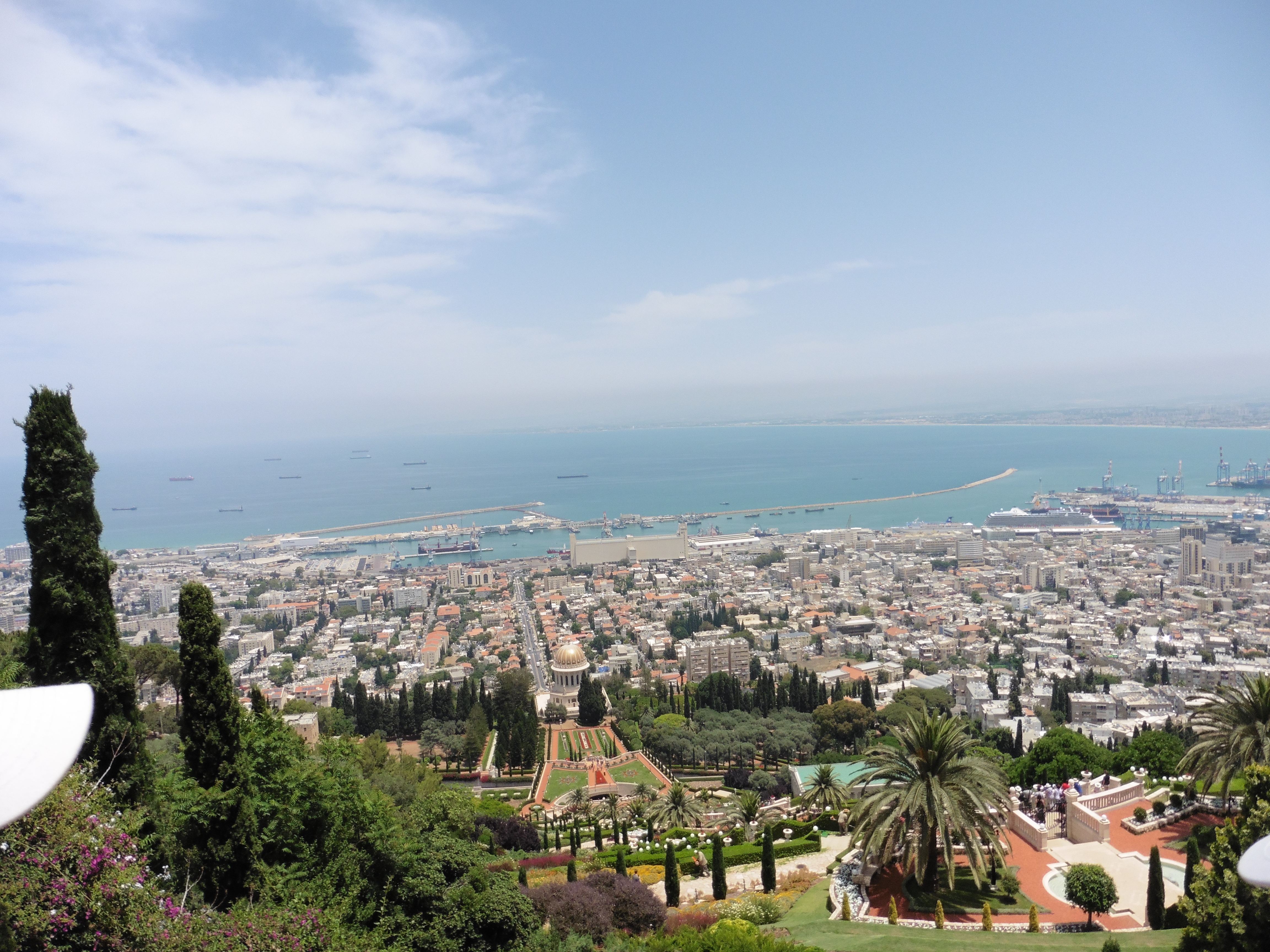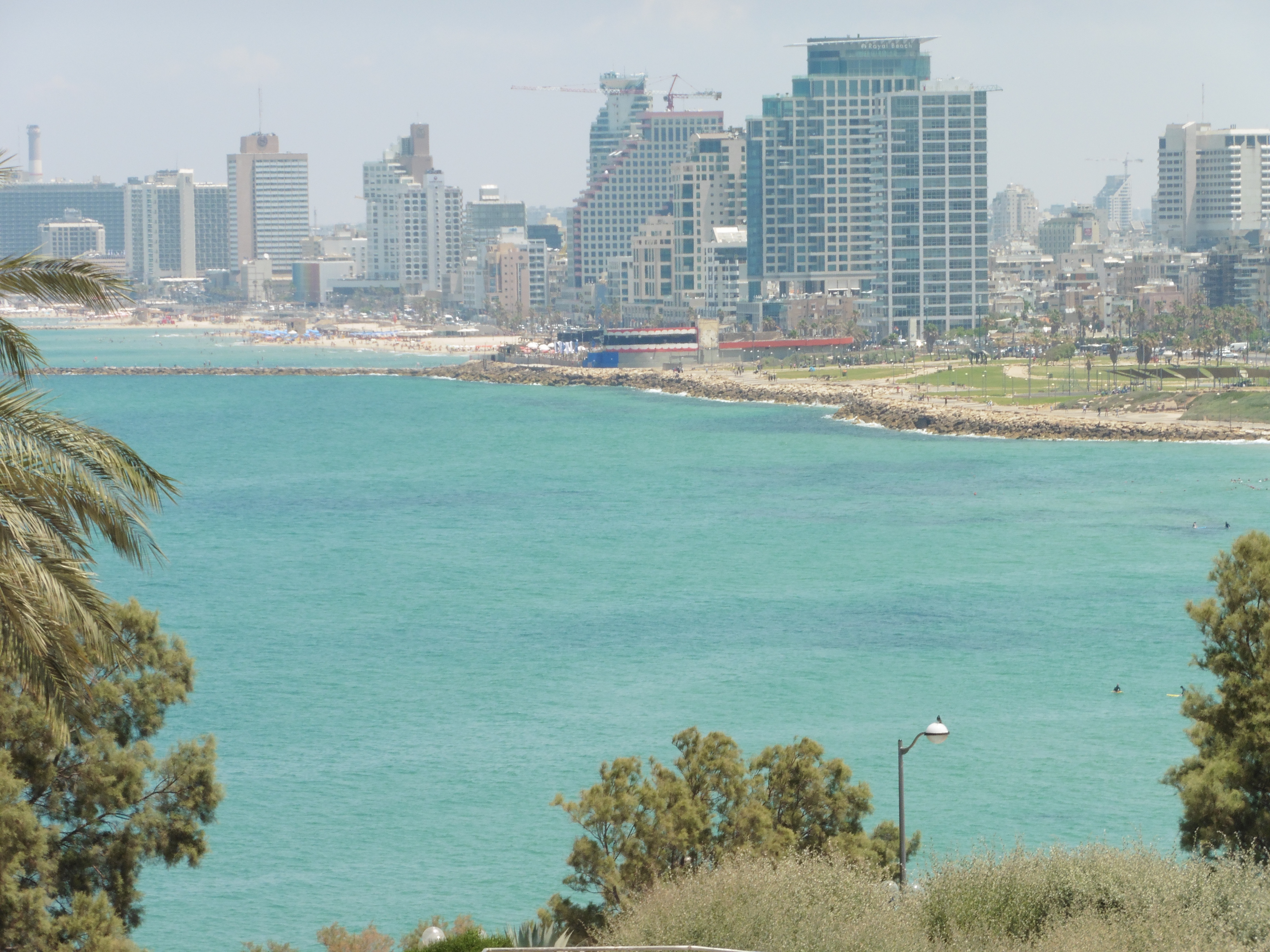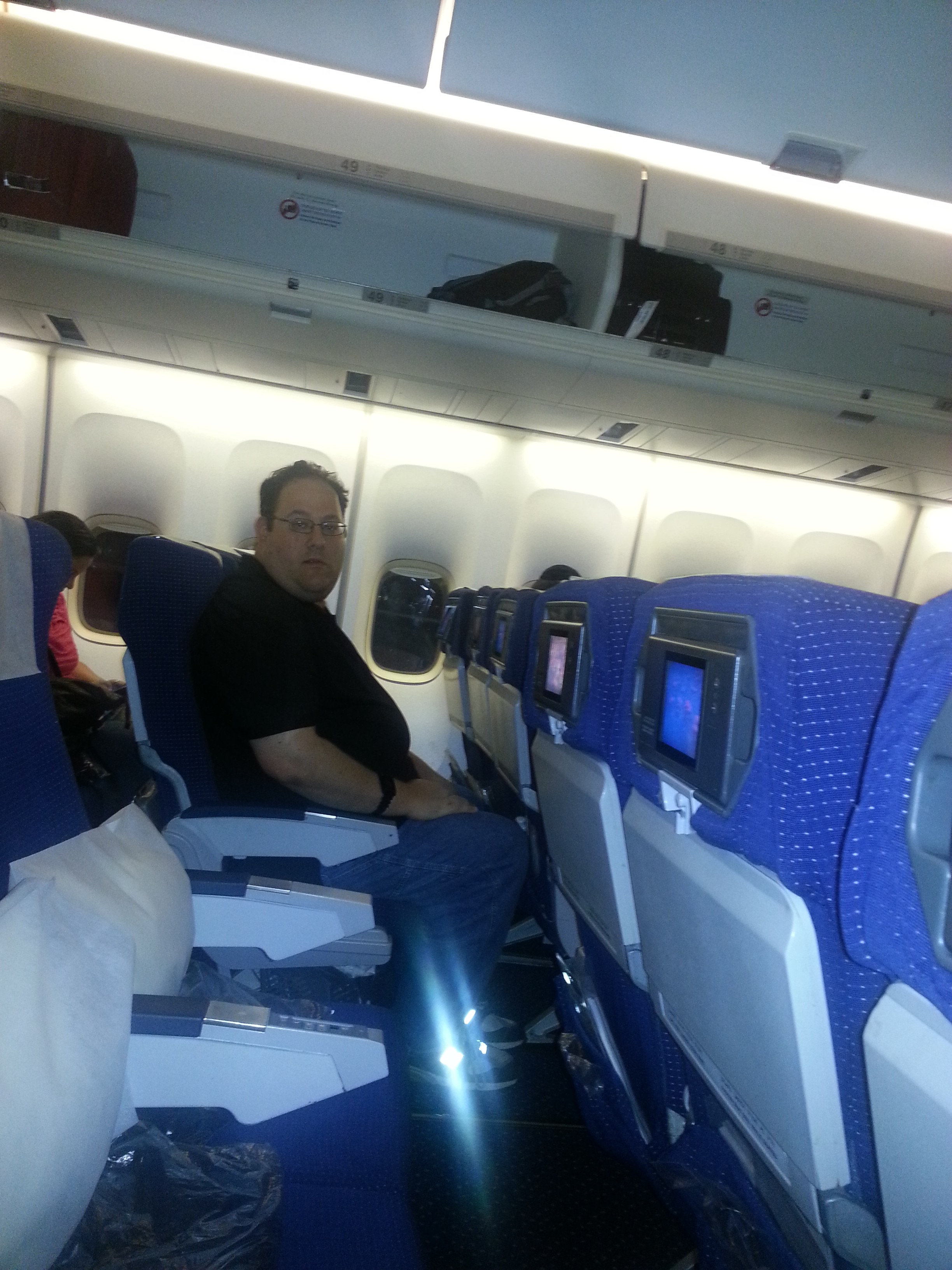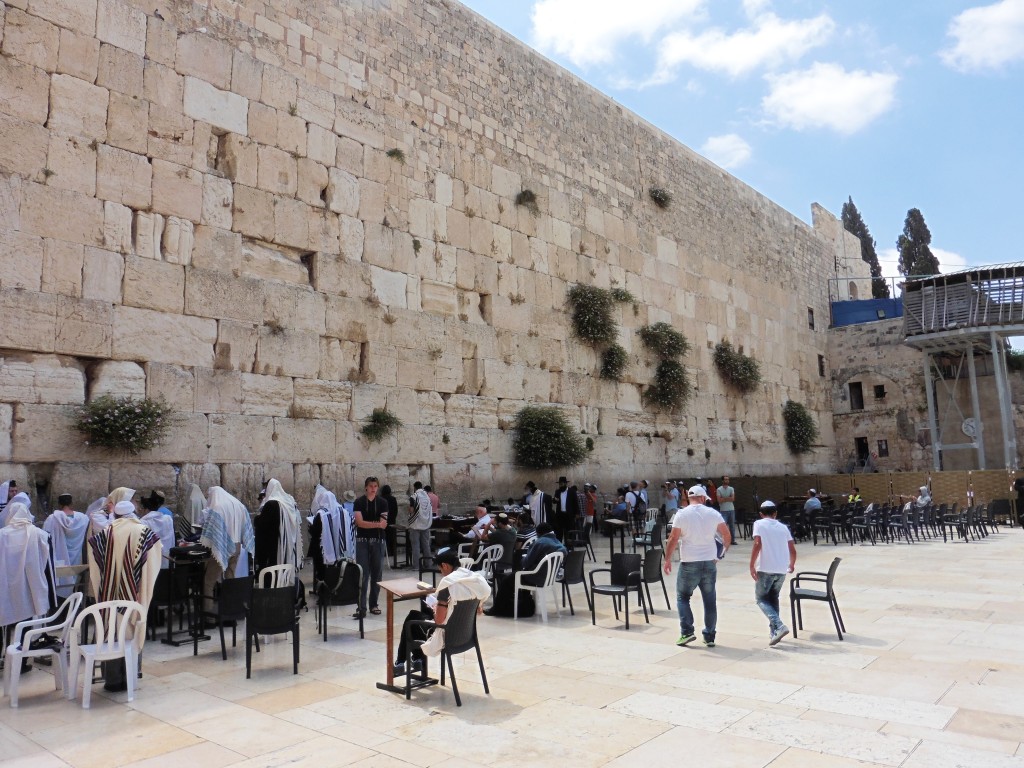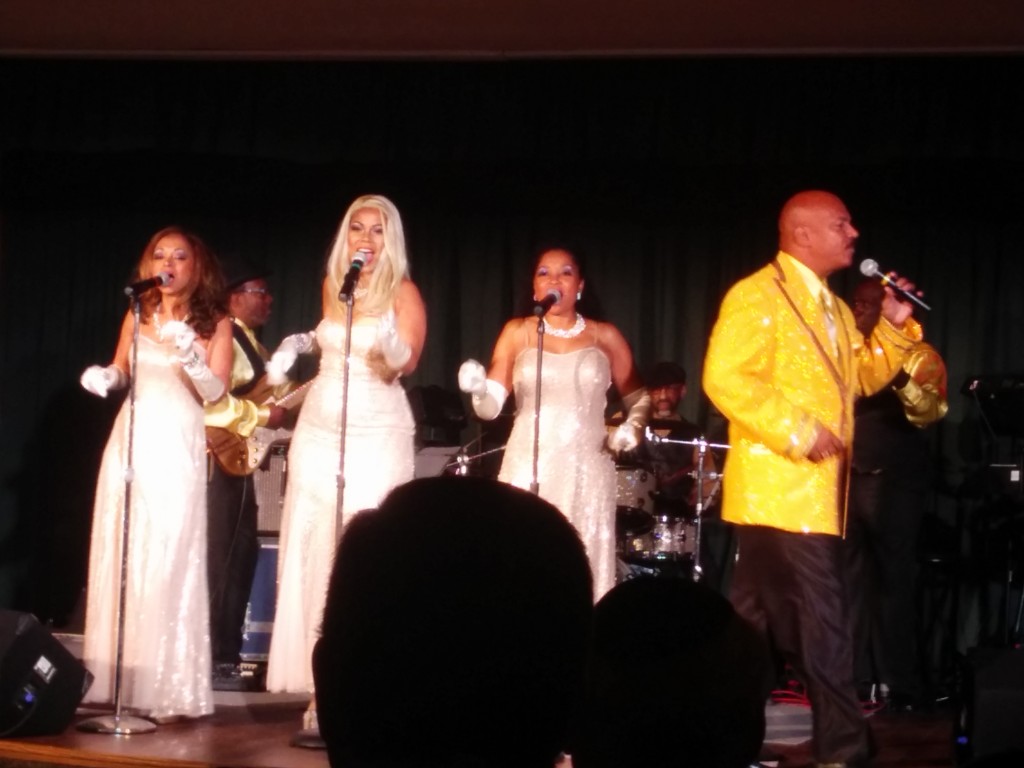
Israel: Part 5 – Mitzpe Gadot, the Banias Springs, and Tel Hai
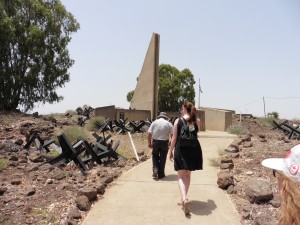
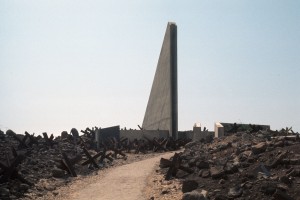
“As the smoke subsided, thousands of Galilee settlers, climbed out of their shelters. For the first time in nearly 20 years they could look up at the Golan Heights with pride instead of fear.”
At Mitzpe Gadot there is a tall, triangular concrete monument to commemorate fallen Israeli soldiers of the 33rd Battalion of the Golani Brigade, located at one of the former Syrian bases as well as several subsequent conflicts.
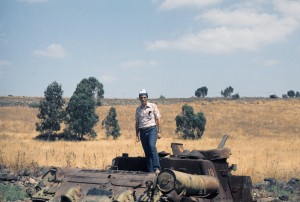
You realize how small Israel actually is when you figure out how close the Lebanon, Syrian, and Jordan borders are. Israel is only slightly larger than New Jersey.
After this, we headed to the Banias, a spring associated with the Greek deity Pan. An ancient shrine to Pan was discovered here. I couldn’t learn about it, because in order to listen to the informational message on the shrine of Pan, you had to pay. I cheaped out, so I had to read about it on my phone.
The Banias was captured from the Syrians on my birthday, June 10th, 1967(prior to actual date of birth) from the Syrians, as part of an attempt to secure against the previously mentioned efforts to divert water away from Israel.
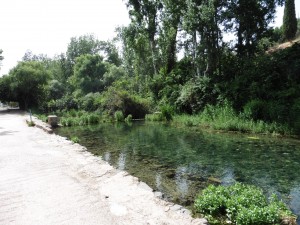
During this point, we were extremely close to the Syrian border and the Lebanon border…and later on the Jordan border. We were within sight of the United Nations Disengagement Observer Force, established in 1974. The UNDOF administrated buffer zone is 50 miles long, and 146 square miles, and seems likely to continue indefinitely. The mission has been attacked several times during the recent Syrian Civil War.
Quneitra, a controversial city in Syria, was a distant view away. In the 50s, the population of the city was about 20,000. The city was abandoned by the Syrians, who falsely
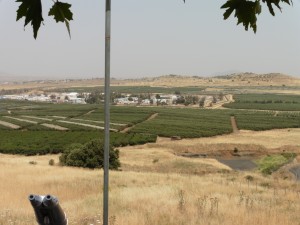
broadcast it had been conquered by the Israelis. The Israelis took advantage of the confusion to actually conquer the city. Syria shelled the abandoned city several times during the 1970s. The year after the Yom Kippur War, in 1974, the Israelis agreed to return the city to Syria under the condition it be repopulated as a sign of peaceful intentions between the two nations.
Syria has built a museum to memorialize the city’s destruction. They discourage repopulation of the area and have left it in its destroyed condition.
The final stop of the day was the Tel Hai monument. In 1999, I had stayed at the nearby Tel Hai Youth Hostel on my trip, but I do not have any recollection of visiting the monument.
In 1919, the British relinquished Tel Hai to French jurisdiction. The local Arabs wanted to be part of the new Arab Kingdom of Syria rather than under French rule. Zionists in Tel Hai remained neutral. The area was subject to frequent border readjustments. However, as newcomers they were suspected of being pro-French.
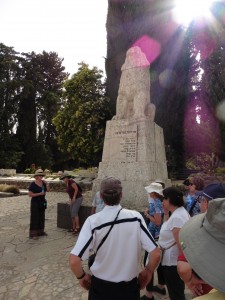
On March 1, 1920, several hundred Shiites attacked Tel Hai. Initially demanding to search the Kibbutz for French soldiers, violence escalated. There is some historical dispute about how things played out. Either the search was a ruse, or a series of misunderstandings escalated into a full conflict which ultimately killed eight Jews and ultimately led to the destruction of the village.
The city of Kiryat Shemonah is named after the eight Jews who died during the Battle of Tel Hai.
This ended Monday.
We’re still not at Jerusalem. Next time on Israel…Part 6: Tiberias, Beit Shean, Beit Alpha, and Gan Hashlosha…before we arrive into Jerusalem.
Israel: Part 4 – Tsfat, the Golan Heights
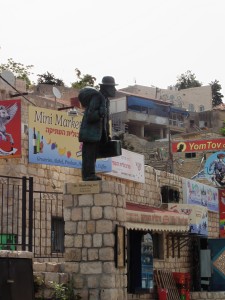
On Sunday evening, we arrived at Kibbutz Lavi. Kibbutz Lavi’s hotel facility is one of their main sources of income and popular with Orthodox Jews. They also make synagogue furniture and engage in the traditional Kibbutz business of agriculture. Agriculture is no longer the primary business of any kibbutz, from what I understand.
Compared to the two hotels I visited, the room was nice, the wifi at the Kibbutz was good, the staff was friendly, and the food…left a bit to be desired. The eggs were powdered, for example. It seemed to be more like a public school cafeteria.
Tzfat was the first stop on Monday. It is the highest city in Israel in terms of elevation. The Jewish presence in the city dates back to the Middle Ages. After the Spanish Inquisition expelled the Jews from Spain, it became a center of Jewish learning, and is considered a center of Kaballah even to this day. Notably, Joseph Caro, the author of the Shulchan Aruch and Shlomo Halevi Alkabetz, composer of Lecha Dodi, which is sung as part of the Friday evening service.
In Tzfat, we visited a gallery of artwork by Nicky Imber. Imber was an artist who was so skilled, when at Dachau, he’d been able to make a mask out of break and sand of one of the Nazi soldiers, steal a uniform, and walk out of the gates of the camp. His sculptures are still famous worldwide.
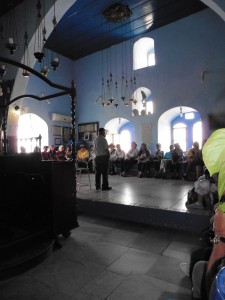
We then visited the Joseph Caro synagogue, built in the 16th century, and rebuilt after a 1759 and an 1837 Earthquake. It was originally a place of learning, and didn’t become a synagogue until 1903.
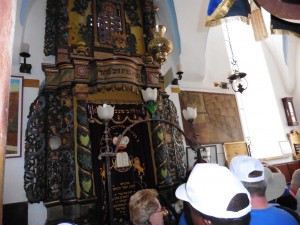
The other synagogue visited was the Ha’ Ari Synagogue, built in honor of Rabbi Isaac Luria, the Ari. It may be the oldest synagogue in Israel still in active use. The distinction is questionable, because there are many repeatedly destroyed synagogues that have been rebuilt, in some cases after many years of destruction, including the Karaite Synagogue in Jerusalem.
After touring both, we wandered around the Artist’s Quarter…otherwise known as random people trying to sell us things. There were some nice items, but nothing so nice I could see myself hauling it around for a week to bring home. The most surprising part was a woman who greeted us “Good Morning” and called me out when she didn’t hear my low and noncommittal response. It turned out, by odd coincidence, when we did speak to her, she had grown up in Westchester and had gone to school with my cousin. Small world.
Later that day, we headed toward the Golan Heights, taking a jeep tour of the area. And when I say a jeep tour, I mean it. Bumpy unpaved roads, dust flying everywhere(and me wearing a dark shirt that day)…certainly an experience.
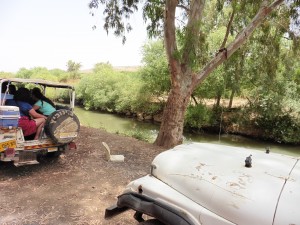
And then we get to the Jordan River. There it is….surprisingly tiny, isn’t it? I’m assuming that when Johnny Cash sung about waiting on the Far Bank of the River Jordan…he hadn’t seen it.
The Jordan River is 156 miles long, running from its sources to the Sea of Galilee, and then a lower section down to the Dead Sea. South of the Sea of Galilee, it forms the border between Israel and the Kingdom of Jordan. The flow of the Jordan has been sharply reduced by Israel, Jordan, and Syria. Prior to the Six-Day War, in 1965, Syria, Jordan, and Lebanon attempted to divert some of the sources of the Jordan River in order to reduce Israel’s water supply.
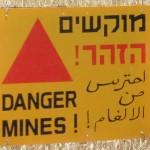 I remember visiting the Golan Heights the last time I was in Israel. And I remember signs like these, and being told that they still, years after the Golan Heights were captured in 1967 and annexed in 1981, the mines were still a threat. The Heights are a plateau, from which the Syrian Army attacked Israeli communities in the valley below by firing artillery shells. Without getting into the politics of it, which date back to 1923, returning the Golan Heights to Syria would leave Israel at significant risk.
I remember visiting the Golan Heights the last time I was in Israel. And I remember signs like these, and being told that they still, years after the Golan Heights were captured in 1967 and annexed in 1981, the mines were still a threat. The Heights are a plateau, from which the Syrian Army attacked Israeli communities in the valley below by firing artillery shells. Without getting into the politics of it, which date back to 1923, returning the Golan Heights to Syria would leave Israel at significant risk.
On June 6th, 1967, Syria launched three attacks against Israeli positions. On June 8th, 48 years to the day that I was there, the Israeli Air Force bombarded the Syrian positions on the Golan Heights.
After 16 years, it is hard to reconstruct the last trip I took here, but it was part of the March of the Living, and I was asked to take notes. I’ve pulled what I wrote that day, after writing my recollection of the more recent trip.
Tuesday, April 20, 1999 – We had gone up the mountain in jeeps, and also returned that way for a nature hike, which was cut short. Bret Gutstein once again appears in this document, hitting me with a large piece of bamboo.
I looked up Bret Gutstein…I believe she is now running a bagel seasoning business in New York.
More on 1999 later, especially since, combining all this material makes me think my narrative here is going to last a lot more parts…we haven’t even reached Jerusalem yet. I had forgotten I still had this notebook till I was writing about the Golan Heights.
Next time on Israel….we visit the the Memorial at Mitzpe Gadot, the Banias Springs, and Tel Hai. And more…Israel: Then and Now.
Israel: Part 3 – Caeserea, Haifa, Rosh Hanikra
Drive north to tour Caesarea, once the Roman capital of the region. See the excavations of the crusaders’ city, the aqueduct and amphitheater which has been restored as a concert venue. Proceed to Haifa for a panoramic view from Mount Carmel and visit “AF AL PI CHEN”, the naval museum of the illegal immigration to Israel at the time of the British mandate. Drive to Acre; walk along the old harbor and local market; continue to the northernmost point of Israel at Rosh Hanikra. Descend by cable car into the limestone grottoes.
Sunday morning we bid a fond farewell to the Dan Panorama Tel Aviv and met up with our tour. To our surprise, it was the same guide from Friday. But now we had a full sized bus, more people, and a separate driver.
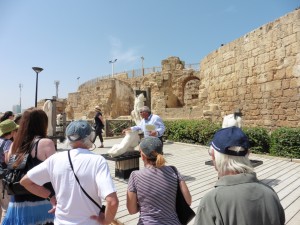
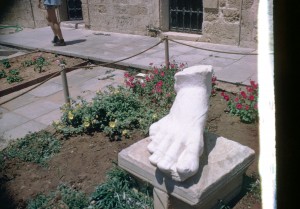
Our first stop was the ancient city of Caeserea. Under the leadership of King Herod, whom our guide spent the entire work referring to as “that meshuganah paranoid”, Caeserea was transformed from a small village into an important port city. Caeserea is also home to the country’s only 18 hole golf course.
The Park is where much of the ruins exist, and have been excavated.
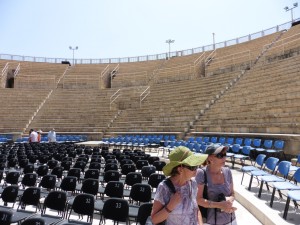
At the Caesarea Park, we ran into a group on Birthright Israel. Birthright has always been a sensitive topic for me. I went on March of the Living in 1999, and was told that made me ineliglble for Birthright, which is a free trip to Israel for college-age kids. Meanwhile, people who had been to Israel dozens of times seemed to be going for free. And I felt there was more for me to see.
The rules, from what I understand, were changed, and one person who went on March of the Living later told me he went on Birthright. But, no use crying over spilt milk. I was never in Tel Aviv during that trip. Look for future editions of Israel: Then and Now…1972, 1974, 1999, and 2015. We’ll see how things have changed.
The Roman Theater at Caeserea has been rebuilt, and now serves as a venue for music.
Caeserea also began my continual search for water fountains during the course of the trip. Apparently, for a desert country…the idea of public water is not as common as you’d think. The park did have water, which is good.
After we left the park, we headed toward Haifa, stopping for lunch at a small mall, where I had a tuna sandwich. We picked Aroma, which is interesting in that it is an Israeli coffee chain that is currently available in cities around the world. The first U.S. Branch opened in 2006. There are 10 in New York, for example.
Haifa is the third largest city in Israel, and a majore seaport. Built on the slopes of Mount Carmel, unlike Tel Aviv, it seemed like it would be a place I would want to see more of. However, it is built into the side of a mountain. I learned when I went to school in Ithaca that a large amount of steep hills is an issue for me.

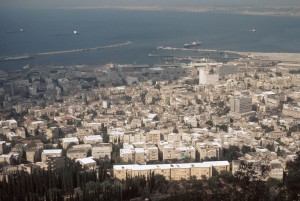

And once again, we have Haifa as it appeared then and now. We stopped for this picture of us in our official Costco Sunhats, apparently very popular on our tour group.
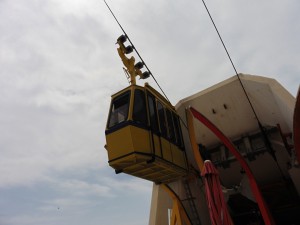
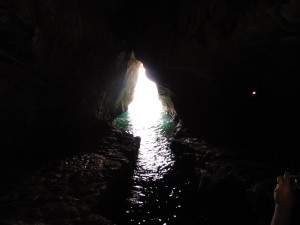

We did not, despite the itinerary, visit the Naval Museum. We took a walk through the city of Akko before headed toward one of my favorite sites, Rosh Hanikra. I realized I did not take any pictures in Akko.
Rosh Hanikra is a series of grottos very near the Lebanese border, accessible by what may be the steepest cable car in the world. Nearby is the sealed railway tunnel to Lebanon. The tunnel was built in 1943 to connect Cairo and Istanbul, created a single route that could extend all the way through to Europe. However, the tunnel was sealed, and reportedly was never used for civilian service.
The day ended at Kibbutz Lavi. More on that in Part 4, where we visit Tsfat.
Israel: Part 2 – Tel Aviv
We arrived in Tel Aviv late, as previously mentioned. the tour group had arranged transport to the hotel. The tour company offers a 9 and 11 day tour. We ended up with 10, joining in on half of the two day Tel Aviv tour they offered. On the last trip I took to Israel, circa 1999 as part of the March of the Living, we had gone straight to Jerusalem. I had never seen Tel Aviv.
By the time we got settled in to the Dan Panorama Tel Aviv, we were both very tired. We went to the concierge to ask for a place nearby that would give us a quick bite to eat before bed. Which was my first mistake. I’m used to concierges not being perfect, but…every time I asked a hotel employee for local information…it was not particularly helpful(more on that later).
He insisted we needed a reservation, and booked us into a local Italian place about 15 minutes walk through the dark streets. When we arrived, reservations seemed to not be needed, and they were most disappointed the two of us only shared an individual pizza and drank tap water and left. Guess we weren’t worth the kickback to the concierge for sending us there.
I had secured prepaid SIM cards for our phones, which were supposed to allow unlimited incoming calls, and 1GB of data. Couldn’t successfully get a single incoming call, but the data worked wonderfully. I would have pursued it, but I couldn’t call anyone. Considering the horribly slow wifi at the Dan Panorama in Tel Aviv and in Jerusalem(which prevented me from uploading pictures most of the time), if I went back, I’d pay for more data and just give up on using theirs.
It was then I tried to use Skype to call my cousin, who could barely hear us, over the hotel wifi, to make arrangements to see him.
Friday, June 5th, 2015
“Visit the Diaspora Museum; drive around the main streets of Tel Aviv, center of business and entertainment of Israel. Stop at Rabin’s Square, place of assassination of Prime Minister Yitzhak Rabin. Continue to Old Jaffa, an 8000 year old port city; visit the ancient ruins and walk along the restored artists’ quarter. Visit Neve Tzedek, the first neighborhood of Tel Aviv, built in 1909 and Nahalat Benyamin, the pedestrian street of the city with its musicians, hand made jewelry and artifacts. Next, stop at Sheinkin, the lively and colorful street especially known for the unique shops, café life and youthful ambiance.”
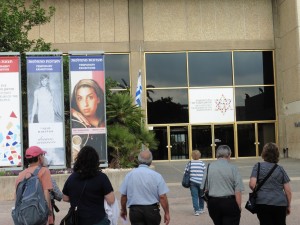 As the day started on Friday, we had breakfast in the hotel and went downstairs to wait in the lobby with our Tour Company hats so we could be identified. It was then we met our tour guide. The tour was conducted with a mini bus he drove around Tel Aviv. He didn’t say another word till he picked up the rest of the tour group at various local hotels, then began his spiel. Most of the people had been with him the previous day, I suppose.
As the day started on Friday, we had breakfast in the hotel and went downstairs to wait in the lobby with our Tour Company hats so we could be identified. It was then we met our tour guide. The tour was conducted with a mini bus he drove around Tel Aviv. He didn’t say another word till he picked up the rest of the tour group at various local hotels, then began his spiel. Most of the people had been with him the previous day, I suppose.
The first stop was Beit Hatfutsot, the Museum of the Jewish People. The museum opened in 1978…and I believe they must need money, because the English lettering is falling off the walls in some places, and has not been repaired. Despite that, it was worth a visit. There was an exhibition on superstitions, myths, blessings, prayers, and folk remedies, in Jewish and universal art; another on Volunteers from Abroad in Israel’s War of Independence.
The slant I found on their core exhibition was very Israeli-centric, as to be expected. You come to the realization that museum exhibitions try to distill a subject into a simple way for people to relate to it. So, when you look at a reconstruction of the Rashi Chapel from the Synagogue of Worms(Germany)…what is the meaning behind it?
Either way, the lesson of the Museum’s core exhibit was that Judaism had formed as a unique culture and religion in Israel, and had subsequently scattered after the country was conquered, and as a result Jews had spread around the world. That history takes a central theme in the touring of Israel…especially considering I was on a Jewish-themed tour.
We continued on to Jaffa. As we headed through the streets of Tel Aviv, my father remarked it looked nothing like it did 40 years ago. So, in honor of that…I’m adding a special recurring segment to this little documentation project. I call it…Israel then and Now…featuring Warren Shanske, who was my travelling companion for this trip. Looks the same, right?
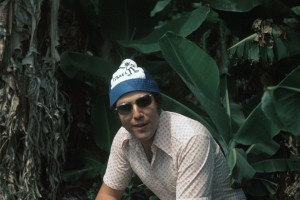
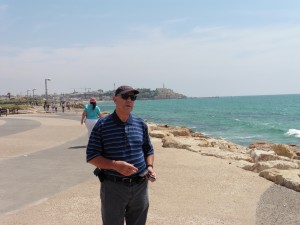
Cities change over time. To my father, Tel Aviv looks like any other city now. It has commercialization, it has tall buildings. But he probably hasn’t noticed some of the drastic changes in New York either.
Back to the city of Jaffa. There has been a major effort over the last quarter century to renovate historic sites, including Muslim ones, in Jaffa over the last 25 years. There has also been increasing gentrification despite a high crime rate, this has had a result of increasing real estate prices and changing demographics.
Tel Aviv and Jaffa have been unified since 1950, and you can see Jaffa is within walking distance of the newer city. My father claimed that was his exercise when he was here in the 70s. He would walk to Jaffa.
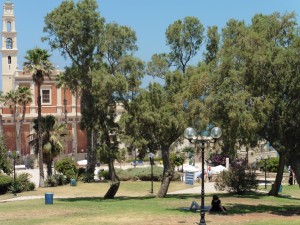
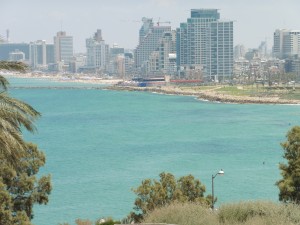
While these are the same spots my father saw 40 years ago, things have certainly changed.
I was a bit hot by this point, so we bought some orange juice. I’m not sure what the margins are on this, but you quickly realize when a man is using a knife and a hand press exactly how many oranges go into a cup of orange juice. Makes me feel wasteful, but no wonder it cost the equivalent of $5.
After we finished in Jaffa, we headed toward the neighborhood of Neve Tzedek, the first neighborhood in Jerusalem. Neve Tzedek was the first neighborhood to be built outside of Jaffa in the 19th century, but by the 1960s, the southern part of Tel Aviv, closest to Jaffa had become a slum and was targeted for urban redevelopment. However, the plan to replace the area with high rises was stopped due to the fact many buildings were on the historic preservation list.
As happens to many neighborhoods like this when preserved, it turned into boutiques, cafes, galleries…a process not unique to Israel, as I see this in the United States as well.
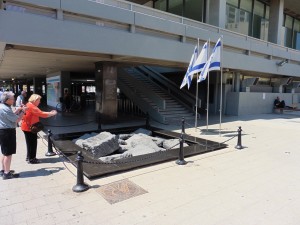
On Saturday, November 4th, 1995, I was in a hotel room in Massachusetts visiting my brother, who was attending Brandeis University, who was in school there. Nightfall came, and I turned on the TV and saw the news that Yitzchak Rabin had been assassinated. It was a shock. Rabin had actually been scheduled to speak at Brandeis not that long after that…an event that never occurred.
The memorial sits, commemorating this event. There is a bust of Rabin nearby, and a commemorative wall. I think our tour guide summarized it best. He didn’t vote for Rabin’s party, but he respected the man. And despite any disagreement, that was who the majority elected, and there would be a chance to vote them out of office in the next election. In the end, that is all we can hope for our leaders and politicians. That we respect them, even if we don’t agree with them, and we represent our opinion with our vote. Welcome to democracy.
The tour concluded early that afternoon, and let us off. The tour guide advised he would come back to take us to the hotels after we wandered around, or we could walk back. My father and I aren’t shopping types, so we wandered a bit, then walked through the Carmel Market and back to the hotel.
We then met up with our cousins for Friday night dinner.
Saturday, June 6th, 2015
We didn’t tour on Saturday. We woke up at 6, which we did every day in Israel, and headed to breakfast, then attended services inside the hotel. After which, we returned to the room for a rest, ate lunch in the hotel, took a walk along the beach, more resting. There were plenty of people out as we walked around.
That night, without any help, we endeavored to find a place to eat. After wandering around, we finally gave up, had some gelato instead of a meal, and went back to bed.
The official tour began Sunday. Stay tuned for Part 3, where we leave the bustling city of Tel Aviv and head to the hills.
Israel: Part 1 – The Plane
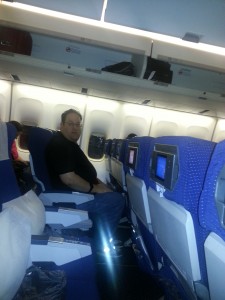
So rarely do I remember what occurred on a trip. Thought I would write it out quickly. This first part deals with air travel. Let’s see if I can cover the whole trip.
Wednesday, June 3, 2015
El Al Flight 008, departing 11:30PM, arriving next day at 4:55PM.
Get a message that LY008 is delayed by one hour. Ends up being 1.5 hours late. Considering how long before the crew shows up, my guess is after the delay, the crew transport was delayed.
I was last on El Al in 1999, on a charter flight from JFK to Krakow, then Warsaw to Tel Aviv, and finally Tel Aviv back to New York. It was the same plane, a 747. There have been some minor changes. They have individual screens…although it is not on demand. I didn’t watch a single second of it.
I didn’t spring for Economy Plus…because it is incredibly hard to do so. The logic of an airline requiring you to apply for the privilege of getting a better seat, as opposed to just selecting one of their website is beyond me. I tried to call and had a less than satisfactory conversation. I was offered a chance to bid on having an empty seat next to me…but fortunately, I got that for free.
Sunday, June 14th, 2015
El Al Flight 001, departing 12:45AM, arriving 5:50AM the same day.
You’ve got to love Israeli security, or maybe you don’t. Before we even got to their airport, there was a checkpoint of armed soldiers checking cars. Then a guy outside the terminal who was watching, and could stop you and inspect you there.
We checked in at a kiosk. Actually the first time I’ve tagged my own bags at a kiosk. That isn’t very common in the U.S. I noticed that despite the fact people got the tags, they didn’t apply them till they got to the counter.
Then there is the Israeli security check, where they ask you questions and put other tags on your bags before you are allowed to proceed to the counter.
After the counter, you get to go through a more traditional security line, where they don’t care about liquids, they don’t ask you to take off your shoes…and this is the highest rated airport security in the world.
Then, you get your exit visa(I got mine from another machine), and head toward the gate.
The Service
The food on El Al was reasonably decent. Each direction served a dinner and a breakfast. There was one single drink service on a 10-11 hour flight, and coffee and tea service with breakfast. Unlike the last time I was on, you could go to the galley if you wanted more to drink. I took a page from the guy next to me and got my own water bottle out of my bag and had them fill it for me so I wouldn’t have to bother them so regularly.
Objectively speaking, the service is good, but the product is somewhat dated compared to many airlines. Delta, having a flight that left around the same time, beat us to and from Tel Aviv. From the employees, it wasn’t the disinterest I remember from last time.
They were all friendly and helpful…except when they refused to speak to the man in front of me on the way out about the fact he reclined his seat before takeoff and left it reclined, even when I was trying to eat. I remember a different airline actually made an announcement asking people to sit up for the meal period so people could eat.
Stay tuned for Part 2: Tel Aviv.
